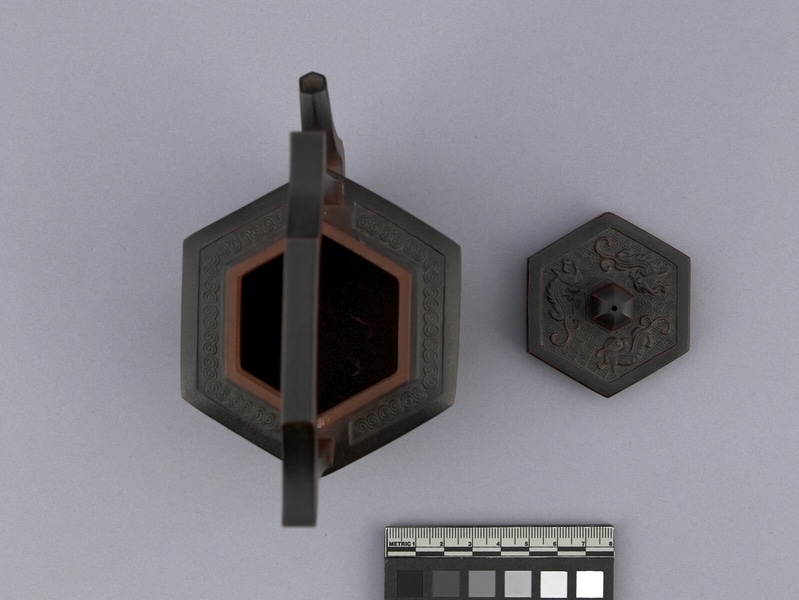Teapot Item Number: Edz1412 a-b from the MOA: University of British Columbia




Description
Hexagonal-shaped teapot (part a) with lid (part b). Teapot tapering slightly outwards from flat base supported at intersections of adjoining planes by low feet. Unglazed body is a lustrous dark red-brown. Hexagonal spout, yoke handle rising from flat shoulders ornamented by moulded scrolling band. Sides consist of two alternating designs on moulded panels with both being variations of fish-dragons on waves. Flat lid with design of three dragons has flange fitting snugly within short hexagonal collar.
History Of Use
The potteries producing I-hsing Ware have been active for thousands of years, although use of the distinctive clay types peculiar to I-hsing itself may date only to the beginning of the Ming Dynasty, 1368 C.E. The sandy clay, varying in shade from light yellow-brown through the best known red-brown to a dark brown-black, has the property of producing a hard lustrous surface when fired, and can therefore be used without glazing. Production has continued to the present time and includes glazed ware, particularly in a brilliant streaked blue-green, as well as the traditional form. The shapes of teapots can be classified in three main groups: those borrowed from archaic bronzes; those borrowed from nature; and those which are geometric.
Iconographic Meaning
Dragons are benevolent and powerful creatures.
Item History
- Made in Jiangsu, China between 1700 and 1800
- Owned by W. W. Winkworth
- Owned by Sotheby's before July 7, 1982
- Received from Fyfe-Smith Memorial Oriental Collection Fund (Funding source) and Sotheby's (Seller) on July 7, 1982
What
Who
- Culture
- Chinese
- Previous Owner
- W. W. Winkworth and Sotheby's
- Received from
- Fyfe-Smith Memorial Oriental Collection Fund (Funding source) and Sotheby's (Seller)
Where
- Holding Institution
- MOA: University of British Columbia
- Made in
- Jiangsu, China
When
- Creation Date
- between 1700 and 1800
- Ownership Date
- before July 7, 1982
- Acquisition Date
- on July 7, 1982
Other
- Item Classes
- ceramics
- Condition
- good
- Accession Number
- 0815/0003 a-b